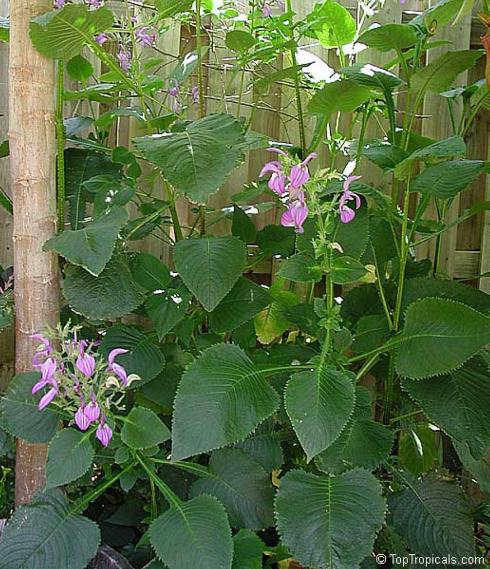Palisot's Giant Sage
Large, heart-shaped leaves and purple sage-like flowers make this tall plant an exotic addition to the garden
Denise Bush
Viernes, 13 de abril 2018, 10:13
Brillantaisia is a genus of about twenty species native to tropical Africa and Madagascar. It is commonly called Giant Sage and although it is not related to the Salvia family, it is certainly a giant. From a spring sowing it can quickly reach 8 to 10 metres tall by 1.5 metres wide, especially in ideal, warm, wet conditions.
The hairy, square stems are similar to those of the mint family but Brillantaisia is part of Acanthaceae. The heart-shaped leaves are large and exotic looking, sometimes with toothed edges; they can measure 15cm long by 7cm wide.
The flowers, which are similar to Salvia, form in loose clusters at the ends of the branches and attract bees and butterflies. The young flowers have a white 'keel' whereas mature flowers are all purple so the overall effect is of bicoloured flowers. After flowering has finished, elongated, cigar-shaped seed pods develop about 30mm long. Once ripe they explode open scattering the flat brown seeds around. The seeds are covered in fine hairs which help them to cling to animals' coats and other surfaces, assisting their dispersal.
In hot and humid parts of Australia, Brillantaisia is classed as invasive as it will happily colonise large areas in ideal conditions. It needs a rich soil, plenty of warmth and moisture and is not drought or frost resistant.
Brillantaisia was first collected by French botanist Ambroise Marie Francois Joseph Palisot, Baron of Beauvois, whose life was beset with bad luck and bad decisions. In Africa most of his collection was destroyed in an attack when the British invaded. He caught yellow fever and went to his uncle's house in Haiti which was later burned in an uprising and his collection there was lost. He was imprisoned and then deported to the US where he was robbed of everything he owned and left destitute. He joined a circus but managed to get a job as a curator for a private botanical collection. He was finally allowed to return to France (after the revolution) but lost everything again when his ship was wrecked off Nova Scotia. It is hardly surprising then that very few of the specimens he collected and recorded have survived.
Calling all gardeners
-
We know that many of our readers have lovely gardens, or enjoy growing plants on their terraces or balconies, so why not share them with others?
-
Email your photos to english@diariosur.es or send them to SUR in English, Avda Dr Marañón 48, 29009 Malaga, with a caption and a few words of explanation. Alternatively, you can send them to us via Facebook (surenglish) or Twitter (@SUR_English)
